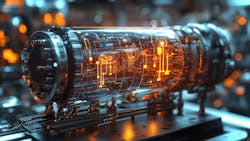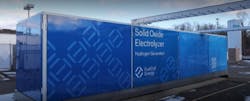FuelCell Energy, Idaho National Lab Studying Hydrogen Generation from Nuclear Power
A U.S-based hydrogen production technology firm is working with the federal Idaho National Laboratory to study how electrolyzers can interact with nuclear power generation to create energy-dense and carbon-free energy resources.
The project with FuelCell Energy will utilize its solid oxide electrolysis cell (SOEC) system in testing at the U.S. Department of Energy’s national lab in Idaho. The project will study how hydrogen production operations can help nuclear plants diversify and increase profitability by alternating to generate both electricity and hydrogen.
The testing will focus on the potential of advanced small modular reactor (SMR) designs of 200 to 500 MW in tandem with FuelCell Energy’s SOEC utility-scale electrolyzers. Both nuclear reactor power generation and hydrogen are carbon-free energy resources, but hydrogen is considered green only if the electrolyzers are powered by zero-carbon resources such as wind, solar, hydro or nuclear.
The Data Center Take on Future Nuclear: Read more
No SMR nuclear projects have been fully developed or commercialized yet, although SMR startups are working with industrial companies and tech firms such as Microsoft, Google and Oracle on developing baseload, clean energy energy connections.
“Pairing FuelCell Energy’s electrolyzer with nuclear plants is an excellent example of the ‘all-of-the-above' energy strategy that is necessary to meet the needs of a strained electric infrastructure,” company CEO Jason Few said in a statement. “Nuclear energy is a baseload power source that when paired with FuelCell Energy’s electrolyzer can ensure that every kilowatt of power is converted into a usable or stored energy resource.”
The FuelCell electrolyzer, which splits the hydrogen from water, will be the largest studied at the Idaho National Lab, according to the release. The electrolyzer project is designed to produce 150 kilograms of hydrogen per day and use only about 250 kilowatts of nuclear-generated electricity.
The process starts with de-ionized water mixed with reclaimed de-ionized water from the unit's chiller. That water is then sent into a steam vaporizer and boiled through a series of heat exchanges before going into SOEC's 16-stack module to convert the steam into hydrogen.
The collaboration also will simulate the benefits of 100% energy efficiency by using waste heat from the nuclear power plant. The Idaho National Lab, which is managed by the Battelle Energy Alliance, long has been a national testing ground for nuclear reactor technology.
The FuelCell Energy modular electrolyzer was shipped to the national lab site from the company’s Connecticut headquarters on two flatbed trucks. The hydrogen produced from this electrolysis will also aid in other Idaho National Lab research on e-chemical synthesis, hydrogen turbine co-firing for power generation, and heavy-duty vehicle refueling.
Federal and private research is working on developing and scaling hydrogen as a carbon-free alternative to gasoline, diesel and methane natural gas both in power generation and transportation.
Hydrogen possesses a relatively high energy density of 120 megajoules per kilogram on a lower heating basis, but is less energy dense on a volumetric basis, according to DOE statistics. The U.S. Inflation Reduction Act offered 30% investment tax credit and production tax credits on clean hydrogen production.
Hydrogen otherwise can be produced from steam reforming methane gas, which is more carbon-intensive than electrolysis.
About the Author
Rod Walton, EnergyTech Managing Editor
Managing Editor
For EnergyTech editorial inquiries, please contact Managing Editor Rod Walton at [email protected].
Rod Walton has spent 17 years covering the energy industry as a newspaper and trade journalist. He formerly was energy writer and business editor at the Tulsa World. Later, he spent six years covering the electricity power sector for Pennwell and Clarion Events. He joined Endeavor and EnergyTech in November 2021.
Walton earned his Bachelors degree in journalism from the University of Oklahoma. His career stops include the Moore American, Bartlesville Examiner-Enterprise, Wagoner Tribune and Tulsa World.
EnergyTech is focused on the mission critical and large-scale energy users and their sustainability and resiliency goals. These include the commercial and industrial sectors, as well as the military, universities, data centers and microgrids. The C&I sectors together account for close to 30 percent of greenhouse gas emissions in the U.S.
He was named Managing Editor for Microgrid Knowledge and EnergyTech starting July 1, 2023
Many large-scale energy users such as Fortune 500 companies, and mission-critical users such as military bases, universities, healthcare facilities, public safety and data centers, shifting their energy priorities to reach net-zero carbon goals within the coming decades. These include plans for renewable energy power purchase agreements, but also on-site resiliency projects such as microgrids, combined heat and power, rooftop solar, energy storage, digitalization and building efficiency upgrades.


